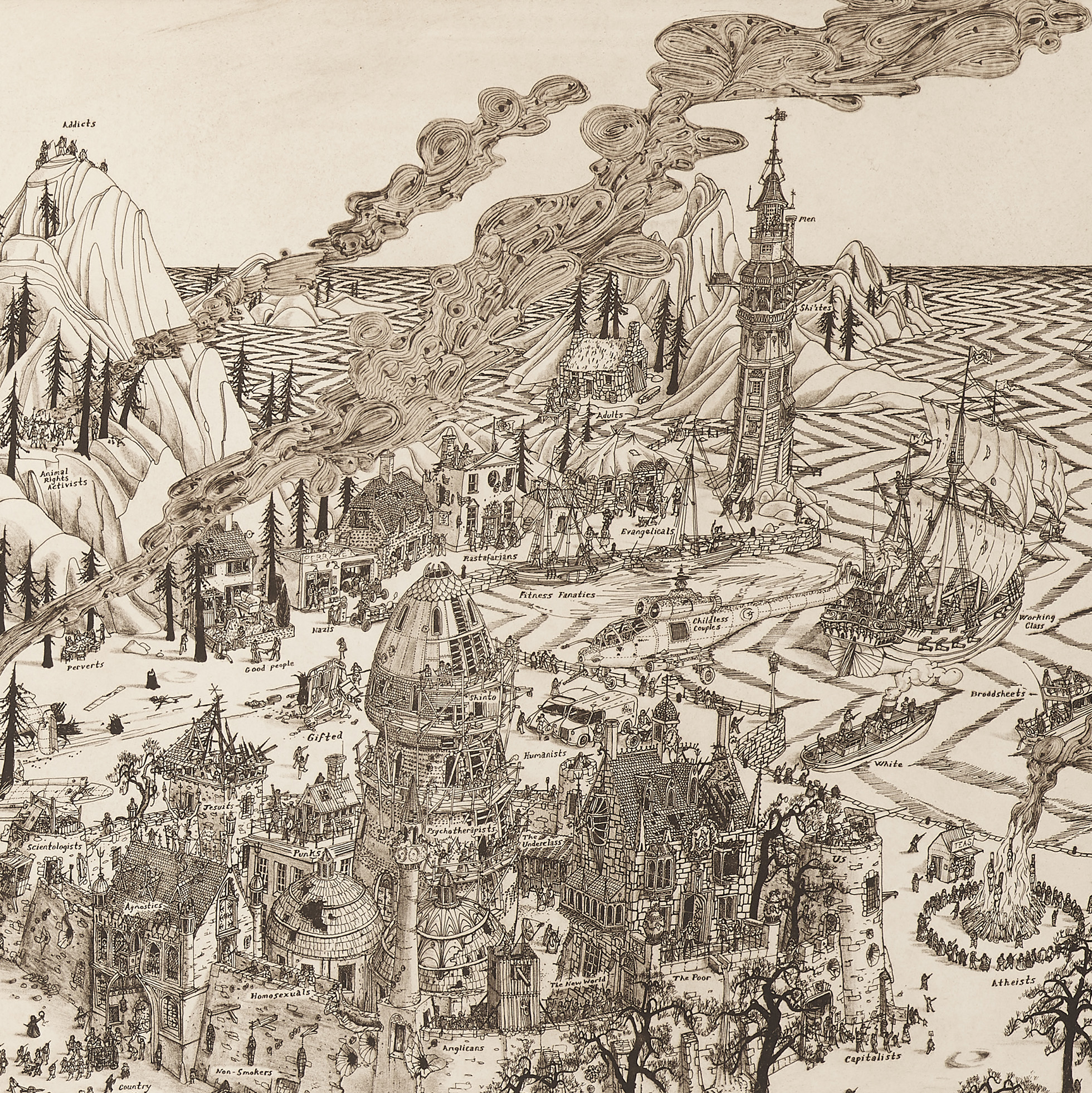Wilmore, Kentucky, is the kind of quaint town (population 6,027) you might drive through and forget. Perhaps if you stop at the intersection of Main Street and Lexington Avenue you may notice a white Presbyterian chapel and a redbrick Baptist church on opposite corners — reminders of a bygone era when America was staunchly Christian.Maybe someone should tell The Economist that those churches are not museums devoted to “a bygone era” — people today actually attend them.
If you’re going to read only one piece about the Asbury revival, make it this one by Ruth Graham. (I won’t let the fact that Ruth was once my student prevent me from saying that she’s the best religion reporter in this country, and it’s not close.)
I don’t have anything further to say about this event, though. Whether this is a genuine fruit-bearing revival is something that can’t be discerned now, and perhaps won’t ever be discernible. As George Eliot teaches us in the famous concluding words of Middlemarch, we don’t really understand the causes of the changes in our lives: sometimes the most important influences, and the most important people, work in ways too subtle for us to perceive. Maybe — and please, Lord, let it be so — this will be a great revival with lasting effects; but we’re unlikely to know what those effects are or how they have shaped people’s hearts. God works in a mysterious way His wonders to perform.
the evacuation of choice
A. O. Scott’s reflection in the NYT on the video record of the horrific murder of Tyre Nichols begins with a question that in so many ways encapasulates our cultural moment: “Do you have a civic duty to watch, or a moral obligation not to?” An important question! — because it has to be one or the other, doesn’t it?
I find myself thinking all the time — because the world I live in gives me constant cause so to think — about the moment early in The Once and Future King when Merlyn turns the Wart into an ant, and the Wart sees this inscription over the doorway to a tunnel:
EVERYTHING NOT FORBIDDEN IS COMPULSORY
And that’s our world, isn’t it? Everything not forbidden is compulsory.
You can see this playing out in the Education Wars conducted especially by this nation’s three most populous states. As David French pointed out in a recent episode of the Advisory Opinions podcast, the governors and legislatures of California, Florida, and Texas are engaged in a strenuous competition to see how thoroughly they can eviscerate the First Amendment rights of their citizens — especially, though not only, in educational contexts. Within public schools at all levels, no position on the hot-button issues of our time can be left to individual or professional discretion.
(Which, among other things, makes me grateful to be employed by a private university — where, by the way, we are also free, unlike this state’s public universities, to make our own decisions about whether people on campus can carry guns.)
Re: Ron DeSantis in particular, I have never — literally never — seen a politician so often and so consistently lied about, by the media and by his political opponents; but whatever your views about the Woke he wants to Stop, if you think him to be a defender of academic freedom you should think again. No, he doesn’t want to prohibit the study of Black people — as lies go that’s an especially stupid one — but he certainly does have an intellectual orthodoxy he wants to enforce. And these days, who doesn’t? What he compels, others would forbid; what he forbids, others would compel. There are limits to political horseshoe theory, but this is one arena where it definitely applies. Some good things may emerge from our current culture ward unscathed, but academic freedom is highly unlikely to be one of them.
Was getting some work done when Angus discovered that he could climb up into my chair. This could end up as my personal equivalent of the moment when the velociraptors learned how to open doors.

Speaking about the prospect of “national divorce” on his radio program, Matt Walsh voiced what I fear is a typical view on the right: He rejects the idea on logistical grounds but is not entirely unsympathetic to it on cultural ones. “Can you name one shared value that binds Americans together?” he asks. “There really is nothing. … In what sense are we a people? The only thing is that we all happen to live within the same borders.” That is, of course, foolishness. If we could force Matt Walsh and Alexandria Ocasio-Cortez to live as neighbors in a village in rural Pakistan (and I do like the idea!), they would soon find out that they not only have a great deal in common but that as a cultural matter they have so much in common that they are very nearly identical.
Imagine if the Supreme Court threw caution to the wind and radically rolled back Section 230 protections; to the point where it became legally unviable to operate any sort of major platform that harvests attention using algorithmic-curation of user-generated content. In this thought experiment, Facebook disappears, along with Twitter, Instagram, Tik Tok, and even YouTube.
This certainly would devastate the tech sector for a while. It would also hurt the portfolios of those invested in these companies. But what would the impact be on the average internet user? It might not actually be so bad.
I would quaver a bit at the loss of YouTube, but … okay. You’ve got a deal. Sign me up.

Finished reading: The Earliest English Poems by Michael J. Alexander 📚
The See of Canterbury combines, impossibly, leadership of the Church of England and of the Anglican Communion. It is hedged in by ancient canonical legal requirements and political pressures born of establishment. But its symbolic weight is irreplaceable. Leave the Archbishop of Canterbury in place, as one of the two primates of the English church, with all that goes with that office. And then create a new episcopal office, the Bishop of Canterbury Cathedral, within the bounds of the grounds. This could be by analogy with the Secretary General, though it would need the agreement of the Church of England. Together build a second cathedra, from the wood of every province, and place it off-center in the sanctuary.
Pause for a moment to consider such a symbol. The Bishop of Canterbury Cathedral, most likely now from the Global South, sits in the chair of the grandparent, spiritually speaking. It will be a chair for an apostolic envoy to the communion, a chair filled with 1,500 years of history, a missionary chair not only in the line of Augustine, but also of Kivebulaya, Azariah, and Luwum and all their global mission colleagues. It will embody the reach of the gospel to the ends of the earth and back to the apostles. And yet the Bishop of Canterbury Cathedral inhabits a cathedral now with two bishops, itself a symbol of complexity and differentiation, and in the midst of that a symbol of collegiality too. The second cathedra evokes deep and ancient memory, of the martyrs, of the margins of the church, whose representative now sits on the chair of authority.
An extraordinary and (to my mind) moving proposal from the good bishop. It is an image of the irresolvable contradictions inherent in the See of Canterbury, but an image also of the Anglican Communion’s determination to live somehow with those contradictions, rather than cutting one another off. It is an acknowledgment of brokenness and a hope for ultimate union. It is as though the whole Anglican world were speaking to one another in the words of Jacob on the banks of the Jabbok: “I will not let you go until you bless me.”
Three Temptations, and Three Triumphs | Philip Jenkins:
Psalm 91 was very famous and well-used, and quoting verse 12 naturally sent you into verse 13. But at this point, the Devil stops. In a sense, he has already said far too much, because any reader of the Psalm knew what came next, and what horribly bad news that was for Satan and his cause. Of course he stops there, because this next verse proclaims the fall of evil forces (like himself), and moreover it contained what were at the time read as evocative messianic references to trampling and serpents.
Naturally, thought some commentators, the Devil would not want to undermine his argument by citing such an embarrassing line. Origen noted this failure to follow through. Incidentally, he also thought that Satan had committed an “exegetical blunder” in suggesting that the Son of God would actually need the help of angels to accomplish anything.
So where did verse 13 go? Why did Jesus not hit Satan back with it? It makes the whole story annoyingly incomplete, and even mysteriously so. In fact, however, if we read Luke’s gospel as a whole, that very v. 13 shortly reappears, centrally and memorably, as Jesus openly proclaimed his messianic mission. Jesus caps Satan’s quotation.
When we read the story of the temptations and the wilderness, we normally read an ending at Luke 4.13: “And when the Devil had ended all the temptation, he departed from him for a season.” But that is not the end of the story. Satan and Jesus would meet again, and sooner in the story than we might expect.

The Castelbarco Tomb, Verona, by John Wharlton Bunney

Currently reading: The Earliest English Poems edited by Michael J. Alexander 📚
books as toys
C. S. Lewis, letter to Arthur Greaves, 1932:
To enjoy a book like [Froissart’s Chronicles] thoroughly I find I have to treat it as a sort of hobby and set about it seriously. I begin by making a map on one of the end leafs: then I put in a genealogical tree or two. Then I put a running headline at the top of each page: finally I index at the end all the passages I have for any reason underlined. I often wonder — considering how people enjoy themselves developing photos or making scrapbooks — why so few people make a hobby of their reading in this way. Many an otherwise dull book which I had to read have I enjoyed in this way, with a fine-nibbed pen in my hand: one is making something all the time and a book so read acquires the charm of a toy without losing that of a book.
UPDATE: A terrific response to this post by my buddy Austin Kleon.
plain speaking
Letter to Eric Fenn of the BBC:
Magdalen College, Oxford.
7th May 1943.
My dear Fenn,
Sorry again. But a talk to the general public on Paradise Lost would be an absolute waste of time. What’s the good of telling them they’ll enjoy it, when we both know they won’t?
yours sincerely,
C. S. Lewis
Re: this explicit deepening of Pope Francis’s hostility to trad Catholics, let me call attention to something I wrote two years ago.

Grayson Perry, detail from Print for a Politician (click to see larger image)
the classics are all right
Re: the recent kerfuffle over the vandalism of Roald Dahl’s books, Walter Kirn tweeted “I ran into two used book stores today and grabbed classics like I was saving them from a fire.” In fact “the classics” are fine — they’re in the public domain and thanks to endeavors like Project Gutenberg and the Internet Archive they are unlikely to be disappeared or bowdlerized. If you’re worried about them, just download the ones you most care about and do what you can, when the supersensitives come with their digital X-Acto knives and their infinite smugness, to let people know how to access the originals.
Likewise, living authors are safe: the supersensitives can demand changes to their works but they don’t have to agree. And if they do agree, well, that’s their business. (But if they agree against the prickings of their conscience, shame on them.)
No, the supersensitives have a rather narrow target: dead writers whose works are still in copyright. Those are the ones vulnerable to vandalism — by those who control the copyright.
his harshest critic
I recently re-read Ruskin’s The Seven Lamps of Architecture, in the third edition of 1880. Ruskin had originally published the book in 1849, when he was 30 years old, and though it had proved quite popular, later in life Ruskin was reluctant to authorize a new edition. His reason? He hated the book.
He finally gave in, but insisted to the publisher that he be given the opportunity to annotate it. The resulting ongoing ill-tempered commentary is very entertaining.
Even when he liked what he had written, he could be cynical. For instance, he approved of the glorious and justly famous passage in which he repudiates the tearing down of old buildings:
Of more wanton or ignorant ravage it is vain to speak; my words will not reach those who commit them, and yet, be it heard or not, I must not leave the truth unstated, that it is again no question of expediency or feeling whether we shall preserve the buildings of past times or not. We have no right whatever to touch them. They are not ours. They belong partly to those who built them, and partly to all the generations of mankind who are to follow us. The dead have still their right in them: that which they laboured for, the praise of achievement or the expression of religious feeling, or whatsoever else it might be which in those buildings they intended to be permanent, we have no right to obliterate. What we have ourselves built, we are at liberty to throw down; but what other men gave their strength and wealth and life to accomplish, their right over does not pass away with their death; still less is the right to the use of what they have left vested in us only. It belongs to all their successors. It may hereafter be a subject of sorrow, or a cause of injury, to millions, that we have consulted our present convenience by casting down such buildings as we choose to dispense with. That sorrow, that loss, we have no right to inflict.
On the phrase "my words will not reach those who commit them” the older Ruskin wrote, “No, indeed! — any more wasted words than mine throughout life, or bread cast on more bitter waters, I never heard of. This closing paragraph of the sixth chapter is the best, I think, in the book, — and the vainest.”
But he is rarely as kind to himself. Of a passage on the Gothic architecture of Venice he noted, “I have written many passages that are one-sided or incomplete; and which therefore are misleading if read without their contexts or development. But I know of no other paragraph in any of my books so definitely false as this.” And one of the funniest moments comes in response to a passage about neo-Gothic architecture, which was just getting started in 1849:
The stirring which has taken place in our architectural aims and interests within these few years, is thought by many to be full of promise: I trust it is, but it has a sickly look to me.
Ruskin’s comment in 1880:
I am glad to see I had so much sense, thus early; — if only I had had just a little more, and stopped talking, how much life — of the vividest — I might have saved from expending itself in useless sputter, and kept for careful pencil work! I might have had every bit of St. Mark’s and Ravenna drawn by this time. What good this wretched rant of a book can do still, since people ask for it, let them make of it; but I don’t see what it’s to be.
This wretched rant of a book — why didn’t I practice drawing instead?

Currently reading: The Lord of the Rings by J.R.R. Tolkien 📚 (I’ve heard good things, but we’ll see 😉 )
Albert Murray and me
From my new essay for Comment on Albert Murray’s “blues idiom”:
For white North American Christians who perceive themselves as marginalized, disparaged, despised, maybe even persecuted — well, a road map for that territory is all around us, in the experience of black Americans, especially as formulated by the great Albert Murray. And I think Murray would have been glad to see his work applied in this way: he thought, and said all the time, that the lessons of the blues idiom are universal human lessons. “When the Negro musician or dancer swings the blues, he is ... making an affirmative and hence exemplary and heroic response to that which André Malraux describes as la condition humaine.”
The essay is behind a paywall for another month — unless you subscribe to Comment, of course. (Nudge nudge wink wink.) By the way, I love the artwork the editors and designers chose to illustrate the essay, e.g.:


